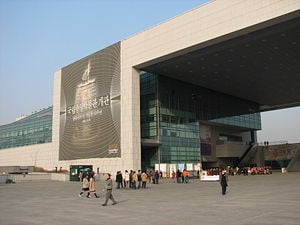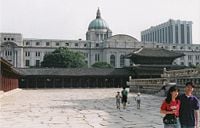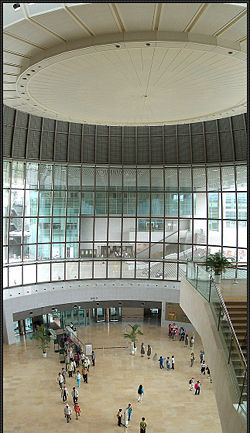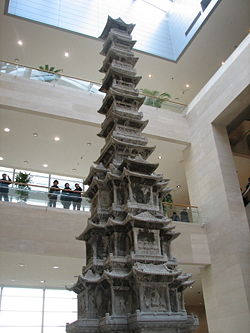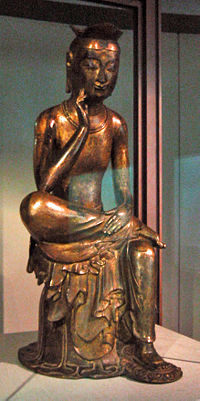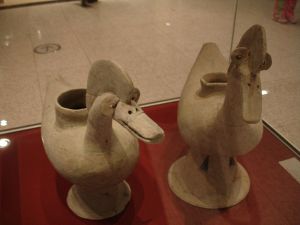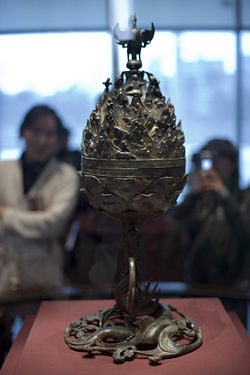Difference between revisions of "National Museum of Korea" - New World Encyclopedia
m (fix) |
Rosie Tanabe (talk | contribs) m |
||
| (6 intermediate revisions by 4 users not shown) | |||
| Line 1: | Line 1: | ||
| − | {{Approved}}{{submitted}}{{images OK}}{{ | + | {{Approved}}{{submitted}}{{images OK}}{{Paid}}{{Copyedited}} |
{{koreanname| | {{koreanname| | ||
image=[[Image:National Museum of Korea.jpg|300px]]<br/>''The exterior of the National Museum of Korea (West wing).'' | | image=[[Image:National Museum of Korea.jpg|300px]]<br/>''The exterior of the National Museum of Korea (West wing).'' | | ||
| Line 5: | Line 5: | ||
hangul=국립중앙박물관 | hanja=國立中央博物館 | rr=Gungnip Jung-ang Bangmulgwan | mr=Kungnip Chung'ang Pangmulgwan}} | hangul=국립중앙박물관 | hanja=國立中央博物館 | rr=Gungnip Jung-ang Bangmulgwan | mr=Kungnip Chung'ang Pangmulgwan}} | ||
The '''National Museum of Korea''' is the repository for the national and cultural treasures of [[Korea]], both [[North Korea|North]] and [[South Korea|South]]. Although the museum envisions itself has a museum for all Korea, the lack of access to explore and recover artifacts in North Korea has severely limited the collection to the South since the [[Korean War]]. Still, artifacts gleened when [[Seoul]] ruled as the capital city for all Korea during the [[Joseon Dynasty]] grace the collection. The displays of [[National treasures of South Korea|National treasures]] within the museum provide a profound look into the soul of Korea through documents and artifacts revealing the [[Korean Art|art]], [[Korean Religions|religion]], [[Korean History|history]], and science of Koreans over history. | The '''National Museum of Korea''' is the repository for the national and cultural treasures of [[Korea]], both [[North Korea|North]] and [[South Korea|South]]. Although the museum envisions itself has a museum for all Korea, the lack of access to explore and recover artifacts in North Korea has severely limited the collection to the South since the [[Korean War]]. Still, artifacts gleened when [[Seoul]] ruled as the capital city for all Korea during the [[Joseon Dynasty]] grace the collection. The displays of [[National treasures of South Korea|National treasures]] within the museum provide a profound look into the soul of Korea through documents and artifacts revealing the [[Korean Art|art]], [[Korean Religions|religion]], [[Korean History|history]], and science of Koreans over history. | ||
| − | + | {{toc}} | |
==Introduction== | ==Introduction== | ||
| − | The National Museum of Korea, the flagship museum of [[Korean history]] and [[Korean art|art]] in [[South Korea]], represents [[Korea]] culturally. Established in 1945, the museum opened in a new building in [[Yongsan Family Park]] in [[Seoul]], October 2005. | + | The National Museum of Korea, the flagship museum of [[Korean history]] and [[Korean art|art]] in [[South Korea]], represents [[Korea]] culturally. Established in 1945, the museum opened in a new building in [[Yongsan Family Park]] in [[Seoul]], October 2005. The museum's collection holds over 150,000 pieces with 11,000 on display at one time. The largest museum in [[Asia]], and the sixth-largest museum in the world in terms of floor space, The National Museum covers 307,227 square feet. |
| − | Measures to protect the treasures inside the museum include engineering the building to withstand a magnitude 6.0 [[Richter Scale]] [[earthquake]]. | + | Measures to protect the treasures inside the museum include engineering the building to withstand a magnitude 6.0 [[Richter Scale]] [[earthquake]]. The display cases for artifacts have been equipped with seismic-protective platforms to absorb shocks and trembles. An imported natural lighting system utilizes sunlight instead of artificial lights and an air purification system has been designed to protect the art and artifacts of the museum. The museum has been made with fire-resistant materials. |
| − | To design the new building, the Korean government held an international competition open to architects around the world to submit a proposal for the new building. | + | To design the new building, the Korean government held an international competition open to architects around the world to submit a proposal for the new building. Architects from 59 countries submitted 854 entries. Chang-Il Kim of Junglim Architects & Engineers Ltd. submitted the winning design, inspired by the idea of a traditional Korean fortress. Oblong in shape, the building looks like a Korean fortress, extending 404 meters in length, and six-stories in height; indigenous plants and gardens surround the building. |
== History == | == History == | ||
| − | [[Image:Japanese General Government Building 1995.jpg|thumb|left|200px|Site of the National Museum of Korea 1995]] | + | [[Image:Japanese General Government Building 1995.jpg|thumb|left|200px|Site of the National Museum of Korea, 1995]] |
| − | Emperor [[Sunjong of Korea|Sunjong]] established Korea's first museum, the Imperial Household Museum, in 1908 | + | Emperor [[Sunjong of Korea|Sunjong]] established Korea's first museum, the Imperial Household Museum, in 1908 in the waning days of the [[Joseon Dynasty]]. The collection of the Imperial Household Museum at [[Changgyeonggung]] and the later Japanese Government General Museum, during the [[Korea under Japanese rule|Japanese rule of Korea]], became the nucleus of the National Museum's collection established when [[South Korea]] gained independence in 1945. |
| − | During the [[Korean War]], the government safely moved the 20,000 of the museum's pieces to [[Busan]] to avoid destruction. | + | During the [[Korean War]], the government safely moved the 20,000 of the museum's pieces to [[Busan]] to avoid destruction. When the artifacts came back to Seoul after the war, curators housed them in [[Gyeongbokgung]] and [[Deoksugung]] Palace. In 1972, the museum moved again to a new building on the grounds of the Gyeongbokgung palace. The museum moved again in 1986 to the [[Jungangcheong]], the former [[Japanese General Government Building, Seoul|Japanese General Government Building]], which housed the museum until demolition in 1995. |
== Layout of the Museum == | == Layout of the Museum == | ||
[[Image:Hall-of-National-Museum-of-Korea.jpg|thumb|right|250px|Hall of the National Museum of Korea]] | [[Image:Hall-of-National-Museum-of-Korea.jpg|thumb|right|250px|Hall of the National Museum of Korea]] | ||
| − | The museum has three | + | The museum has three levels. Symbolically, the left side of the museum represents the past while the right side of the museum represents the future. The first floor contains the Archaeological Gallery containing approximately 4,500 artifacts from the [[Paleolithic]] to the [[Balhae]] era. Ten exhibition rooms comprise the gallery: the Paleolithic Room, [[Jeulmun Pottery Period|Neolithic]] Room, [[Mumun Pottery Period|Bronze Age]] and Early Iron Age Room, [[Proto Three Kingdoms]] Room, [[Goguryeo]] Room, [[Baekje]] Room, [[Gaya]] Room, [[Silla]] Room, [[Unified Silla]] Room, and Balhae Room. The Neolithic and Bronze Age Rooms present artifacts and information from important prehistoric sites and settlements including the [[Bangudae Petroglyphs]] and [[Songgung-ni]]. |
| − | The [[History of Korea|Historical Gallery]], containing recorded and historical documents such as [[Hangul]] inscriptions, maps, and other valuable documents resides on the first floor. | + | The [[History of Korea|Historical Gallery]], containing recorded and historical documents such as [[Hangul]] inscriptions, maps, and other valuable documents resides on the first floor. The Historical Gallery has nine rooms: the Hangeul Room, Prints Room, Inscriptions Room, Documents Room, Map Room, King and His Reign Room, Socio-economic Life Room, [[Korean philosophy|Traditional Thoughts]] Room, and [[Foreign Relations of South Korea|Foreign Relations]] Room. The second floor contains the Fine Arts Gallery I and the Donation Gallery hosting the Painting Room, Calligraphy Room, [[Korean Buddhism|Buddhist Paintings]] Room, and Wooden Craft Room. The Fine Arts Gallery I contains 890 pieces of art in four rooms that explore the traditional and religious arts of Korea in line and color. |
| − | The Donation Gallery holds 1000 pieces of art from a wide variety of cultures donated from | + | The Donation Gallery holds 1000 pieces of art from a wide variety of cultures donated from many private collections. The Donation Gallery hosts the following rooms: the Lee Hong-kun Collection Room, Other Collections Room, Kim Chong-hak Collection Room, Yu Kang-yul Collection Room, Park Young-sook Collection Room, Choi Young-do Collection Room, Park Byong-rae Collection Room, Yoo Chang-jong Collection Room, Kaneko Kazushige Collection Room, Hachiuma Tadasu Collection Room, and Luchi Isao Collection Room. |
| − | Finally, also on the third floor, the [[Asia]]n Arts Gallery contains 970 pieces exploring the similarities and divergences of Asian Art as well as the confluence of Asian and Western art via the [[Silk Road]]. | + | The third floor houses the Fine Arts Gallery II, containing 630 pieces that represent [[Korean Buddhist sculpture]] and craftwork. Highlights of the gallery include [[Goryeo]] [[Celadon]] wares and [[National treasures of South Korea|National Treasure of Korea]] No. 83, the world-renowned [[Bangasayusang]] (or meditating Maiterya). The gallery has five rooms: Metal Arts Room, Celadon Room, Buncheong Ware Room, White Porcelain Room, and Buddhist Sculpture Room. |
| + | |||
| + | Finally, also on the third floor, the [[Asia]]n Arts Gallery contains 970 pieces exploring the similarities and divergences of Asian Art as well as the confluence of Asian and Western art via the [[Silk Road]]. Six rooms make up the gallery: Indonesian Art Room, Central Asian Art Room, Chinese Art Room, Relics from Sinan Seabed Room, Nangnang Remains Room, and Japanese Art Room. The grounds of the museum contain parks, gardens of indigenous plants, waterfalls and pools, a collection of pagodas and other outdoor Korean art. | ||
==National Treasures in the National Museum of Korea== | ==National Treasures in the National Museum of Korea== | ||
| Line 34: | Line 36: | ||
[[Image:Goryeo Pagoda.jpg|thumb|right|250px|The pagoda sits on the first floor of the National Museum of Korea]] | [[Image:Goryeo Pagoda.jpg|thumb|right|250px|The pagoda sits on the first floor of the National Museum of Korea]] | ||
| − | The measure of the importance of the National Museum of Korea is the number and quality of [[National treasures of South Korea|National treasures]] housed in the collection. The following list of National Treasures | + | The measure of the importance of the National Museum of Korea is the vast number and quality of [[National treasures of South Korea|National treasures]] housed in the collection. The following list of National Treasures among the 100 highlighted exhibits in the museum. |
'''[[National treasures of South Korea|National Treasure No. 3]]: The Stele Built to Honor the Expedition of Silla's King Jinheung:''' | '''[[National treasures of South Korea|National Treasure No. 3]]: The Stele Built to Honor the Expedition of Silla's King Jinheung:''' | ||
[http://www.museum.go.kr/eng/collection/sub_01_list.jsp?BUILD_CD=2&PAGE_NUM=1] | [http://www.museum.go.kr/eng/collection/sub_01_list.jsp?BUILD_CD=2&PAGE_NUM=1] | ||
| − | :King Jinheung erected a stele on Mt. [[Bukhansan]] around 555 to mark expanded [[Silla]] territory. | + | :King Jinheung (540-576) erected a stele on Mt. [[Bukhansan]] around the year 555 to mark expanded [[Silla]] territory. |
| − | '''[[National treasures of South Korea|National Treasure No. 60]]: Incense Burner Celadon with Lion-shaped Cover:''' [http://www.museum.go.kr/eng/collection/sub_01_list.jsp?BUILD_CD=4&PAGE_NUM=1] | + | '''[[National treasures of South Korea|National Treasure No. 60]]: Incense Burner Celadon with Lion-shaped Cover:''' <!--[http://www.museum.go.kr/eng/collection/sub_01_list.jsp?BUILD_CD=4&PAGE_NUM=1]—> [http://www.museum.go.kr/kor/images/exh/relics/100/hig100_064_1.jpg] |
| − | :The lion-shaped cover indicated a [[Buddhist]] altar ritual object. Goryeo, | + | :The lion-shaped cover indicated a [[Buddhist]] altar ritual object. Goryeo, twelfth century. H 21.1cm |
| − | '''[[National treasures of South Korea|National Treasure No. 78: Pensive Bodhisattva]]''' [http://www.museum.go.kr/eng/collection/sub_01_list.jsp?BUILD_CD=4&PAGE_NUM=1] | + | '''[[National treasures of South Korea|National Treasure No. 78: Pensive Bodhisattva]]''' <!--[http://www.museum.go.kr/eng/collection/sub_01_list.jsp?BUILD_CD=4&PAGE_NUM=1]—> [http://www.museum.go.kr/kor/images/exh/relics/100/hig100_036_1.jpg] |
| − | :This Buddhist statue wears a tall crown with sun and moon decoration, originating from [[Sassanian Persia]]. Three Kingdoms period, Late | + | :This Buddhist statue wears a tall crown with sun and moon decoration, originating from [[Sassanian Persia]]. Three Kingdoms period, Late sixth century Gilt bronze, H 83.2cm |
| − | '''[[National treasures of South Korea|National Treasure No. 79: Amitābha Buddha]]''' [http://www.museum.go.kr/eng/collection/sub_01_list.jsp?BUILD_CD=4&PAGE_NUM=1] | + | '''[[National treasures of South Korea|National Treasure No. 79: Amitābha Buddha]]''' <!--[http://www.museum.go.kr/eng/collection/sub_01_list.jsp?BUILD_CD=4&PAGE_NUM=1]—> [http://www.museum.go.kr/kor/images/exh/relics/100/hig100_039_1.jpg] |
| − | :From the [[Pagoda]] at the Monastic | + | :From the [[Pagoda]] at the Monastic site of [[Hwangboksa]] (Buddha). |
| − | '''[[National treasures of South Korea|National Treasure No. 80: Buddha]]''' [http://www.museum.go.kr/eng/collection/sub_01_list.jsp?BUILD_CD=4&PAGE_NUM=1] | + | '''[[National treasures of South Korea|National Treasure No. 80: Buddha]]''' <!--[http://www.museum.go.kr/eng/collection/sub_01_list.jsp?BUILD_CD=4&PAGE_NUM=1]—> [http://www.museum.go.kr/kor/images/exh/relics/100/hig100_039_1.jpg] |
| − | :From the Pagoda at the Monastic | + | :From the Pagoda at the Monastic site of [[Hwangboksa]] (Buddha). Made of pure gold, treasures 79 and 80 attracted much attention. Crafted in 692 and 706 respectively. |
| − | '''[[National treasures of South Korea|National Treasure No. 83: Pensive Bodhisattva]]'''. [http://www.museum.go.kr/eng/collection/sub_01_list.jsp?BUILD_CD=4&PAGE_NUM=1] | + | '''[[National treasures of South Korea|National Treasure No. 83: Pensive Bodhisattva]]'''. <!--[http://www.museum.go.kr/eng/collection/sub_01_list.jsp?BUILD_CD=4&PAGE_NUM=1]—> [http://www.museum.go.kr/kor/images/exh/relics/100/hig100_037_1.jpg] |
| − | :Buddha's posture indicates contemplating on human being's life. [[Three Kingdoms Period|Three Kingdoms period]], Early | + | :Buddha's posture indicates contemplating on human being's life. [[Three Kingdoms Period|Three Kingdoms period]], Early senenth century H 93.5cm |
[[Image:Bangasayusang.jpg|thumb|right|200px|Bangasayusang, National Treasure No.83 is one of the most popular works at the museum]] | [[Image:Bangasayusang.jpg|thumb|right|200px|Bangasayusang, National Treasure No.83 is one of the most popular works at the museum]] | ||
| − | '''[[National treasures of South Korea|National Treasure No. 86: Gyeongcheonsa Pagoda]]''' [http://www.museum.go.kr/eng/collection/sub_01_list.jsp?BUILD_CD=4&PAGE_NUM=1] | + | '''[[National treasures of South Korea|National Treasure No. 86: Gyeongcheonsa Pagoda]]''' <!--[http://www.museum.go.kr/eng/collection/sub_01_list.jsp?BUILD_CD=4&PAGE_NUM=1]—> [http://www.museum.go.kr/kor/images/exh/relics/100/hig100_049_1.jpg] |
'''[[National treasures of South Korea|National Treasure No. 89]]: Gold Buckle'''. [http://www.museum.go.kr/eng/collection/sub_01_list.jsp?BUILD_CD=5&PAGE_NUM=1] | '''[[National treasures of South Korea|National Treasure No. 89]]: Gold Buckle'''. [http://www.museum.go.kr/eng/collection/sub_01_list.jsp?BUILD_CD=5&PAGE_NUM=1] | ||
| − | :From the | + | :From the first century <small>C.E.</small>, crafted from pure gold. A huge [[dragon]] decorates the center, around which six small dragons crowd. W 9.4cm |
'''[[National treasures of South Korea|National Treasure No. 90: Gold Earrings]]'''. [http://www.museum.go.kr/eng/collection/sub_01_list.jsp?BUILD_CD=1&PAGE_NUM=1] | '''[[National treasures of South Korea|National Treasure No. 90: Gold Earrings]]'''. [http://www.museum.go.kr/eng/collection/sub_01_list.jsp?BUILD_CD=1&PAGE_NUM=1] | ||
| − | :From the [[Silla]] period, elaborate and magnificnet example of Silla craftsmanship. Silla, | + | :From the [[Silla]] period, elaborate and magnificnet example of Silla craftsmanship. Silla, sixth century <small>C.E.</small>, L 8.7cm |
'''[[National treasures of South Korea|National Treasure No. 91]]: Horse Rider-shaped Vessels''' [http://www.museum.go.kr/eng/collection/sub_01_list.jsp?BUILD_CD=1&PAGE_NUM=1] | '''[[National treasures of South Korea|National Treasure No. 91]]: Horse Rider-shaped Vessels''' [http://www.museum.go.kr/eng/collection/sub_01_list.jsp?BUILD_CD=1&PAGE_NUM=1] | ||
| − | :[[Silla]], | + | :[[Silla]], sixth century <small>C.E.</small>, H 26.8cm. |
'''[[National treasures of South Korea|National Treasure No. 92]]: Ritual Ewer(Kundika)''' [http://www.museum.go.kr/eng/collection/sub_01_list.jsp?BUILD_CD=4&PAGE_NUM=1] | '''[[National treasures of South Korea|National Treasure No. 92]]: Ritual Ewer(Kundika)''' [http://www.museum.go.kr/eng/collection/sub_01_list.jsp?BUILD_CD=4&PAGE_NUM=1] | ||
| − | :Goryeo, | + | :Goryeo, twelfth century, H 37.5cm. A ritual ewer similar to those used by [[Brahmans]] and [[Buddhist]] monks in ancient Inda. |
'''[[National treasures of South Korea|National Treasure No. 94]]: Lobed Bottle Celadon (reportedly from King Injong's Tomb)''' [http://www.museum.go.kr/eng/collection/sub_01_list.jsp?BUILD_CD=4&PAGE_NUM=1] | '''[[National treasures of South Korea|National Treasure No. 94]]: Lobed Bottle Celadon (reportedly from King Injong's Tomb)''' [http://www.museum.go.kr/eng/collection/sub_01_list.jsp?BUILD_CD=4&PAGE_NUM=1] | ||
| − | :[[Goryeo]], | + | :[[Goryeo]], twelfth century, H 22.7cm. Discovered in [[King Injong]] tomb. |
'''[[National treasures of South Korea|National Treasure No. 95]]: Incense Burner Celadon with Openwork Design''' [http://www.museum.go.kr/eng/collection/sub_01_list.jsp?BUILD_CD=4&PAGE_NUM=1] | '''[[National treasures of South Korea|National Treasure No. 95]]: Incense Burner Celadon with Openwork Design''' [http://www.museum.go.kr/eng/collection/sub_01_list.jsp?BUILD_CD=4&PAGE_NUM=1] | ||
| − | :[[Goryeo]], | + | :[[Goryeo]], twelfth century, H 15.3cm. This incense burner has gained international admiration. |
'''[[National treasures of South Korea|National Treasure No. 97]]: Maebyeong, Vase Celadon with Incised Lotus Scroll Design''' [http://www.museum.go.kr/eng/collection/sub_01_list.jsp?BUILD_CD=4&PAGE_NUM=1] | '''[[National treasures of South Korea|National Treasure No. 97]]: Maebyeong, Vase Celadon with Incised Lotus Scroll Design''' [http://www.museum.go.kr/eng/collection/sub_01_list.jsp?BUILD_CD=4&PAGE_NUM=1] | ||
| − | :[[Goryeo]], | + | :[[Goryeo]], twelfth century, H 43.9cm. This vase exemplies the beauty of [[Goryeo celadon]]. |
'''[[National treasures of South Korea|National Treasure No. 98]]: Jar Celadon with Inlaid Peony Design''' [http://www.museum.go.kr/eng/collection/sub_01_list.jsp?BUILD_CD=4&PAGE_NUM=1] | '''[[National treasures of South Korea|National Treasure No. 98]]: Jar Celadon with Inlaid Peony Design''' [http://www.museum.go.kr/eng/collection/sub_01_list.jsp?BUILD_CD=4&PAGE_NUM=1] | ||
| Line 83: | Line 85: | ||
'''[[National treasures of South Korea|National Treasure No. 113]]: Bottle Celadon with Willow Design in Underglaze Iron-brown''' [http://www.museum.go.kr/eng/collection/sub_01_list.jsp?BUILD_CD=4&PAGE_NUM=1] | '''[[National treasures of South Korea|National Treasure No. 113]]: Bottle Celadon with Willow Design in Underglaze Iron-brown''' [http://www.museum.go.kr/eng/collection/sub_01_list.jsp?BUILD_CD=4&PAGE_NUM=1] | ||
| − | :[[Goryeo]], | + | :[[Goryeo]], twelfth century, H 31.4cm. The design and composition give thise celadon a contemporary feel. |
[[Image:Xcoldricex11.jpg|thumb|right|250|Duck-shaped pottery at the National Museum of Korea.]] | [[Image:Xcoldricex11.jpg|thumb|right|250|Duck-shaped pottery at the National Museum of Korea.]] | ||
'''[[National treasures of South Korea|National Treasures No. 116]]: Gourd-Shaped Pitcher Celadon with Inlaid Peony Scroll Design''' [http://www.museum.go.kr/eng/collection/sub_01_list.jsp?BUILD_CD=4&PAGE_NUM=1] | '''[[National treasures of South Korea|National Treasures No. 116]]: Gourd-Shaped Pitcher Celadon with Inlaid Peony Scroll Design''' [http://www.museum.go.kr/eng/collection/sub_01_list.jsp?BUILD_CD=4&PAGE_NUM=1] | ||
| − | :[[Goryeo]], | + | :[[Goryeo]], twelfth century, H 34.7cm. Inverse inlaying technique highlights this celadon. |
'''[[National treasures of South Korea|National Treasure No. 119]]: Buddha with Inscription of the Seventh Year of Yeonga''' [http://www.museum.go.kr/eng/collection/sub_01_list.jsp?BUILD_CD=4&PAGE_NUM=1] | '''[[National treasures of South Korea|National Treasure No. 119]]: Buddha with Inscription of the Seventh Year of Yeonga''' [http://www.museum.go.kr/eng/collection/sub_01_list.jsp?BUILD_CD=4&PAGE_NUM=1] | ||
| Line 93: | Line 95: | ||
'''[[National treasures of South Korea|National Treasure No. 125]]: Funeral Urns''' [http://www.museum.go.kr/eng/collection/sub_01_list.jsp?BUILD_CD=1&PAGE_NUM=1] | '''[[National treasures of South Korea|National Treasure No. 125]]: Funeral Urns''' [http://www.museum.go.kr/eng/collection/sub_01_list.jsp?BUILD_CD=1&PAGE_NUM=1] | ||
| − | :[[Unified Silla]], | + | :[[Unified Silla]], eighth century, H 16.4cm. With the advent of [[Korean Buddhism|Buddhism]] in [[Silla]], cremation became widespread. This funeral urn is from the Silla period. |
'''[[National treasures of South Korea|National Treasure No. 126]]: Spotless Pure Light Dharani Sutra''' [http://www.museum.go.kr/eng/collection/sub_01_list.jsp?BUILD_CD=2&PAGE_NUM=1] | '''[[National treasures of South Korea|National Treasure No. 126]]: Spotless Pure Light Dharani Sutra''' [http://www.museum.go.kr/eng/collection/sub_01_list.jsp?BUILD_CD=2&PAGE_NUM=1] | ||
| − | :[[Unified Silla]], | + | :[[Unified Silla]], eighth century. The oldest wood printing block print in the world, found in the [[Seokgatap]] Pagoda at [[Bulguksa]]. |
'''[[National treasures of South Korea|National Treasure No. 131]]: Register of King Taejo''' [http://www.museum.go.kr/eng/collection/sub_01_list.jsp?BUILD_CD=2&PAGE_NUM=1] | '''[[National treasures of South Korea|National Treasure No. 131]]: Register of King Taejo''' [http://www.museum.go.kr/eng/collection/sub_01_list.jsp?BUILD_CD=2&PAGE_NUM=1] | ||
| Line 109: | Line 111: | ||
'''[[National treasures of South Korea|National Treasure No. 166]]: Jar White Porcelain with Plum and Bamboo Design in Underglaze Iron-brown''' [http://www.museum.go.kr/eng/collection/sub_01_list.jsp?BUILD_CD=4&PAGE_NUM=1] | '''[[National treasures of South Korea|National Treasure No. 166]]: Jar White Porcelain with Plum and Bamboo Design in Underglaze Iron-brown''' [http://www.museum.go.kr/eng/collection/sub_01_list.jsp?BUILD_CD=4&PAGE_NUM=1] | ||
| − | :[[Joseon]], | + | :[[Joseon]], sixteenth century. |
'''[[National treasures of South Korea|National Treasure No. 170]]: Jar White Porcelain with Plum, Bamboo and Bird Design in Underglaze Cobalt-blue''' [http://www.museum.go.kr/eng/collection/sub_01_list.jsp?BUILD_CD=4&PAGE_NUM=1] | '''[[National treasures of South Korea|National Treasure No. 170]]: Jar White Porcelain with Plum, Bamboo and Bird Design in Underglaze Cobalt-blue''' [http://www.museum.go.kr/eng/collection/sub_01_list.jsp?BUILD_CD=4&PAGE_NUM=1] | ||
| − | :Joseon, | + | :Joseon, fifteenth-sixteenth century, |
'''[[National treasures of South Korea|National Treasure No.175]]: Bowl White Porcelain with Inlaid Lotus Scroll Design :Joseon, 15th century''' [http://www.museum.go.kr/eng/collection/sub_01_list.jsp?BUILD_CD=4&PAGE_NUM=1] | '''[[National treasures of South Korea|National Treasure No.175]]: Bowl White Porcelain with Inlaid Lotus Scroll Design :Joseon, 15th century''' [http://www.museum.go.kr/eng/collection/sub_01_list.jsp?BUILD_CD=4&PAGE_NUM=1] | ||
| Line 118: | Line 120: | ||
'''[[National treasures of South Korea|National Treasure No. 191]]: Gold Crown'''[http://www.museum.go.kr/eng/collection/sub_01_list.jsp?BUILD_CD=1&PAGE_NUM=1] | '''[[National treasures of South Korea|National Treasure No. 191]]: Gold Crown'''[http://www.museum.go.kr/eng/collection/sub_01_list.jsp?BUILD_CD=1&PAGE_NUM=1] | ||
| − | :[[Silla]], | + | :[[Silla]], fifth century. Discovered in [[Gyeongju]], North tomb. |
'''[[National treasures of South Korea|National Treasure No. 193]]: Glassware''' [[http://www.museum.go.kr/eng/collection/sub_01_list.jsp?BUILD_CD=1&PAGE_NUM=1]] | '''[[National treasures of South Korea|National Treasure No. 193]]: Glassware''' [[http://www.museum.go.kr/eng/collection/sub_01_list.jsp?BUILD_CD=1&PAGE_NUM=1]] | ||
| − | :[[Silla]], | + | :[[Silla]], fifth century. excavated form king's tomb glassware indicates high class. |
'''[[National treasures of South Korea|National Treasure No. 195]]: Jar with Figurines''' [http://www.museum.go.kr/eng/collection/sub_01_list.jsp?BUILD_CD=1&PAGE_NUM=1] | '''[[National treasures of South Korea|National Treasure No. 195]]: Jar with Figurines''' [http://www.museum.go.kr/eng/collection/sub_01_list.jsp?BUILD_CD=1&PAGE_NUM=1] | ||
| − | :[[Silla]], | + | :[[Silla]], fifth century. Made of clay, shaped in the images of people, animals, daily life tools express the folk belief and emotion of the time. |
'''[[National treasures of South Korea|National Treasure No. 246]]: Maharatnakuta Sutra''' [http://www.museum.go.kr/eng/collection/sub_01_list.jsp?BUILD_CD=2&PAGE_NUM=1] | '''[[National treasures of South Korea|National Treasure No. 246]]: Maharatnakuta Sutra''' [http://www.museum.go.kr/eng/collection/sub_01_list.jsp?BUILD_CD=2&PAGE_NUM=1] | ||
| − | :Goryeo, | + | :Goryeo, eleventh century. Daebojeokgyeong or '''Maharatnakuta Sutra''' contains an important collection of passages from Mahayana Buddhism. |
'''[[National treasures of South Korea|National Treasure No. 259]]: Jar Buncheong Ware with Inlaid Dragon and Stamped Design''' [http://www.museum.go.kr/eng/collection/sub_01_list.jsp?BUILD_CD=4&PAGE_NUM=1] | '''[[National treasures of South Korea|National Treasure No. 259]]: Jar Buncheong Ware with Inlaid Dragon and Stamped Design''' [http://www.museum.go.kr/eng/collection/sub_01_list.jsp?BUILD_CD=4&PAGE_NUM=1] | ||
| − | :[[Joseon dynasty|Joseon]], | + | :[[Joseon dynasty|Joseon]], fifteenth century. A masterpiece of beauty of Buncheong ware. |
'''[[National treasures of South Korea|National Treasure No. 260]]: Turtle-shaped Bottle Buncheong Ware with Sgraffito Peony Design and Underglaze Iron-brown Decoration''' [http://www.museum.go.kr/eng/collection/sub_01_list.jsp?BUILD_CD=4&PAGE_NUM=1] | '''[[National treasures of South Korea|National Treasure No. 260]]: Turtle-shaped Bottle Buncheong Ware with Sgraffito Peony Design and Underglaze Iron-brown Decoration''' [http://www.museum.go.kr/eng/collection/sub_01_list.jsp?BUILD_CD=4&PAGE_NUM=1] | ||
| − | :Joseon, | + | :Joseon, fifteenth century. a turtle-shaped bottle use for water and liquor in Joseon period. |
'''[[National treasures of South Korea|National Treasure No. 272]]: Treatise on the 17 Stages of the Yoga Practice''' [http://www.museum.go.kr/eng/collection/sub_01_list.jsp?BUILD_CD=6&PAGE_NUM=1] | '''[[National treasures of South Korea|National Treasure No. 272]]: Treatise on the 17 Stages of the Yoga Practice''' [http://www.museum.go.kr/eng/collection/sub_01_list.jsp?BUILD_CD=6&PAGE_NUM=1] | ||
| − | :[[Goryeo]], | + | :[[Goryeo]], eleventh century. When [[Kitan]] invaded [[Gaegyeong]] in 1011, Goryeo [[King Hyeonjong]] ordered [[Chojo Tripitaka]] to be made. These are pages from that printing. |
'''[[National treasures of South Korea|National Treasure No. 280]]: Buddhist Bell From Cheonheung-sa Temple''' [http://www.museum.go.kr/eng/collection/sub_01_list.jsp?BUILD_CD=4&PAGE_NUM=1] | '''[[National treasures of South Korea|National Treasure No. 280]]: Buddhist Bell From Cheonheung-sa Temple''' [http://www.museum.go.kr/eng/collection/sub_01_list.jsp?BUILD_CD=4&PAGE_NUM=1] | ||
| Line 149: | Line 151: | ||
:93. White porcelain jar with grape design in underglaze iron. | :93. White porcelain jar with grape design in underglaze iron. | ||
:96. Celadon pitcher in the shape of a tortoise. | :96. Celadon pitcher in the shape of a tortoise. | ||
| − | :99. [[Galhangsa]] Temple | + | :99. [[Galhangsa]] Temple three-Story stone pagoda. |
| − | :100. [[Namgyewon Monastery]] | + | :100. [[Namgyewon Monastery]] seven-Story stone pagoda. |
:101. Memorial Stupa for the Most Reverend [[Jigwang]] of [[Beopcheonsa]] temple. | :101. Memorial Stupa for the Most Reverend [[Jigwang]] of [[Beopcheonsa]] temple. | ||
:102. Memorial Stupa for the Most Reverend [[Hongbeop]] of [[Jeongtosa]] temple. | :102. Memorial Stupa for the Most Reverend [[Hongbeop]] of [[Jeongtosa]] temple. | ||
| Line 158: | Line 160: | ||
:114. Celadon bottle in the shape of a muskmelon with inlaid peony and chrysanthemum designs. | :114. Celadon bottle in the shape of a muskmelon with inlaid peony and chrysanthemum designs. | ||
:115. Celadon bowl with inlaid arabesque design. | :115. Celadon bowl with inlaid arabesque design. | ||
| − | :124. | + | :124. Seated marble [[bodhisattva]] statue of Hansongsa temple. |
:127. Standing gilt-bronze [[avalokitesvara bodhisattva]] statue of Samyang-dong. | :127. Standing gilt-bronze [[avalokitesvara bodhisattva]] statue of Samyang-dong. | ||
:167. Celadon wine pot in the shape of a human figure. | :167. Celadon wine pot in the shape of a human figure. | ||
:168. White porcelain bottle with plum and chrysanthemum designs in underglaze iron. | :168. White porcelain bottle with plum and chrysanthemum designs in underglaze iron. | ||
| − | :185. [[Saddharmapundarika sutra]], | + | :185. [[Saddharmapundarika sutra]], "The White Lotus of the Real Truth" |
:186. Standing gilt-bronze bodhisattva statue from Yangpyeong. | :186. Standing gilt-bronze bodhisattva statue from Yangpyeong. | ||
| − | :207. Saddle flap with 'heavenly horse' painting, from the Heavenly Horse Tomb. | + | :207. Saddle flap with 'heavenly horse' painting, from the Heavenly Horse Tomb, Kyongju. |
:239. Portrait of [[Song Siyeol]]. | :239. Portrait of [[Song Siyeol]]. | ||
:245. Index of [[Tripitaka Koreana|Tripitaka]] volume 20. | :245. Index of [[Tripitaka Koreana|Tripitaka]] volume 20. | ||
| Line 175: | Line 177: | ||
<!--{{more sources|date=December 2006}}—> | <!--{{more sources|date=December 2006}}—> | ||
<!--=== Past Exhibit: Treasures from Pyongyang Exhibit === | <!--=== Past Exhibit: Treasures from Pyongyang Exhibit === | ||
| − | Ninety significant cultural artifacts displayed at the National Museum of Korea loaned by the Korean Central History Museum in [[Pyongyang]] until August 16, 2006, then moved to the Taegu National Museum from August 28 to October 26, 2006.[http://www.museum.go.kr/eng/display/special_view.jsp] North and South curators designed the exhibit to engender other cultural property exchanges between the two Koreas. | + | Ninety significant cultural artifacts displayed at the National Museum of Korea loaned by the Korean Central History Museum in [[Pyongyang]] until August 16, 2006, then moved to the Taegu National Museum from August 28 to October 26, 2006.[http://www.museum.go.kr/eng/display/special_view.jsp] North and South curators designed the exhibit to engender other cultural property exchanges between the two Koreas. Noteworthy among the collection: a bird bone flute from 2000 B.C.E., the oldest extant musical instrument from Korea. [http://www.korea-is-one.org/article.php3?id_article=2415]. A bronze statue of [[Taejo of Goryeo|Wang Geon]], the first king of the Goryeo Dynasty tops the list for important items exhibted. Standing 138.3 centimeter in height, archeologist excavated the statue in 1992 at his mausoleum in [[Kaesong]]. Believed originally dressed in royal clothes, the statue's clothing has disappeared. North Korea loaned famous paintings from the Joseon Dynasty for the exhibit.—> |
== Gallery == | == Gallery == | ||
| Line 200: | Line 202: | ||
*Yi, Park, and Suzanne Crowder Han. 2005. National Museum of Korea. Seoul: National Museum of Korea. OCLC: 71719875 | *Yi, Park, and Suzanne Crowder Han. 2005. National Museum of Korea. Seoul: National Museum of Korea. OCLC: 71719875 | ||
| − | + | [[Category:Korea]] | |
| − | |||
| − | |||
| − | |||
| − | |||
| − | |||
| − | |||
| − | |||
| − | |||
| − | |||
| − | |||
| − | |||
| − | [[Category: | ||
| − | |||
| − | |||
| − | |||
[[Category:Geography]] | [[Category:Geography]] | ||
[[Category:History]] | [[Category:History]] | ||
| + | {{credits|110932231}} | ||
Latest revision as of 17:49, 22 December 2014
The National Museum of Korea is the repository for the national and cultural treasures of Korea, both North and South. Although the museum envisions itself has a museum for all Korea, the lack of access to explore and recover artifacts in North Korea has severely limited the collection to the South since the Korean War. Still, artifacts gleened when Seoul ruled as the capital city for all Korea during the Joseon Dynasty grace the collection. The displays of National treasures within the museum provide a profound look into the soul of Korea through documents and artifacts revealing the art, religion, history, and science of Koreans over history.
Introduction
The National Museum of Korea, the flagship museum of Korean history and art in South Korea, represents Korea culturally. Established in 1945, the museum opened in a new building in Yongsan Family Park in Seoul, October 2005. The museum's collection holds over 150,000 pieces with 11,000 on display at one time. The largest museum in Asia, and the sixth-largest museum in the world in terms of floor space, The National Museum covers 307,227 square feet.
Measures to protect the treasures inside the museum include engineering the building to withstand a magnitude 6.0 Richter Scale earthquake. The display cases for artifacts have been equipped with seismic-protective platforms to absorb shocks and trembles. An imported natural lighting system utilizes sunlight instead of artificial lights and an air purification system has been designed to protect the art and artifacts of the museum. The museum has been made with fire-resistant materials.
To design the new building, the Korean government held an international competition open to architects around the world to submit a proposal for the new building. Architects from 59 countries submitted 854 entries. Chang-Il Kim of Junglim Architects & Engineers Ltd. submitted the winning design, inspired by the idea of a traditional Korean fortress. Oblong in shape, the building looks like a Korean fortress, extending 404 meters in length, and six-stories in height; indigenous plants and gardens surround the building.
History
Emperor Sunjong established Korea's first museum, the Imperial Household Museum, in 1908 in the waning days of the Joseon Dynasty. The collection of the Imperial Household Museum at Changgyeonggung and the later Japanese Government General Museum, during the Japanese rule of Korea, became the nucleus of the National Museum's collection established when South Korea gained independence in 1945.
During the Korean War, the government safely moved the 20,000 of the museum's pieces to Busan to avoid destruction. When the artifacts came back to Seoul after the war, curators housed them in Gyeongbokgung and Deoksugung Palace. In 1972, the museum moved again to a new building on the grounds of the Gyeongbokgung palace. The museum moved again in 1986 to the Jungangcheong, the former Japanese General Government Building, which housed the museum until demolition in 1995.
Layout of the Museum
The museum has three levels. Symbolically, the left side of the museum represents the past while the right side of the museum represents the future. The first floor contains the Archaeological Gallery containing approximately 4,500 artifacts from the Paleolithic to the Balhae era. Ten exhibition rooms comprise the gallery: the Paleolithic Room, Neolithic Room, Bronze Age and Early Iron Age Room, Proto Three Kingdoms Room, Goguryeo Room, Baekje Room, Gaya Room, Silla Room, Unified Silla Room, and Balhae Room. The Neolithic and Bronze Age Rooms present artifacts and information from important prehistoric sites and settlements including the Bangudae Petroglyphs and Songgung-ni.
The Historical Gallery, containing recorded and historical documents such as Hangul inscriptions, maps, and other valuable documents resides on the first floor. The Historical Gallery has nine rooms: the Hangeul Room, Prints Room, Inscriptions Room, Documents Room, Map Room, King and His Reign Room, Socio-economic Life Room, Traditional Thoughts Room, and Foreign Relations Room. The second floor contains the Fine Arts Gallery I and the Donation Gallery hosting the Painting Room, Calligraphy Room, Buddhist Paintings Room, and Wooden Craft Room. The Fine Arts Gallery I contains 890 pieces of art in four rooms that explore the traditional and religious arts of Korea in line and color.
The Donation Gallery holds 1000 pieces of art from a wide variety of cultures donated from many private collections. The Donation Gallery hosts the following rooms: the Lee Hong-kun Collection Room, Other Collections Room, Kim Chong-hak Collection Room, Yu Kang-yul Collection Room, Park Young-sook Collection Room, Choi Young-do Collection Room, Park Byong-rae Collection Room, Yoo Chang-jong Collection Room, Kaneko Kazushige Collection Room, Hachiuma Tadasu Collection Room, and Luchi Isao Collection Room.
The third floor houses the Fine Arts Gallery II, containing 630 pieces that represent Korean Buddhist sculpture and craftwork. Highlights of the gallery include Goryeo Celadon wares and National Treasure of Korea No. 83, the world-renowned Bangasayusang (or meditating Maiterya). The gallery has five rooms: Metal Arts Room, Celadon Room, Buncheong Ware Room, White Porcelain Room, and Buddhist Sculpture Room.
Finally, also on the third floor, the Asian Arts Gallery contains 970 pieces exploring the similarities and divergences of Asian Art as well as the confluence of Asian and Western art via the Silk Road. Six rooms make up the gallery: Indonesian Art Room, Central Asian Art Room, Chinese Art Room, Relics from Sinan Seabed Room, Nangnang Remains Room, and Japanese Art Room. The grounds of the museum contain parks, gardens of indigenous plants, waterfalls and pools, a collection of pagodas and other outdoor Korean art.
National Treasures in the National Museum of Korea
The measure of the importance of the National Museum of Korea is the vast number and quality of National treasures housed in the collection. The following list of National Treasures among the 100 highlighted exhibits in the museum.
National Treasure No. 3: The Stele Built to Honor the Expedition of Silla's King Jinheung: [1]
- King Jinheung (540-576) erected a stele on Mt. Bukhansan around the year 555 to mark expanded Silla territory.
National Treasure No. 60: Incense Burner Celadon with Lion-shaped Cover: [2]
- The lion-shaped cover indicated a Buddhist altar ritual object. Goryeo, twelfth century. H 21.1cm
National Treasure No. 78: Pensive Bodhisattva [3]
- This Buddhist statue wears a tall crown with sun and moon decoration, originating from Sassanian Persia. Three Kingdoms period, Late sixth century Gilt bronze, H 83.2cm
National Treasure No. 79: Amitābha Buddha [4]
- From the Pagoda at the Monastic site of Hwangboksa (Buddha).
National Treasure No. 80: Buddha [5]
- From the Pagoda at the Monastic site of Hwangboksa (Buddha). Made of pure gold, treasures 79 and 80 attracted much attention. Crafted in 692 and 706 respectively.
National Treasure No. 83: Pensive Bodhisattva. [6]
- Buddha's posture indicates contemplating on human being's life. Three Kingdoms period, Early senenth century H 93.5cm
National Treasure No. 86: Gyeongcheonsa Pagoda [7]
National Treasure No. 89: Gold Buckle. [8]
- From the first century C.E., crafted from pure gold. A huge dragon decorates the center, around which six small dragons crowd. W 9.4cm
National Treasure No. 90: Gold Earrings. [9]
- From the Silla period, elaborate and magnificnet example of Silla craftsmanship. Silla, sixth century C.E., L 8.7cm
National Treasure No. 91: Horse Rider-shaped Vessels [10]
- Silla, sixth century C.E., H 26.8cm.
National Treasure No. 92: Ritual Ewer(Kundika) [11]
- Goryeo, twelfth century, H 37.5cm. A ritual ewer similar to those used by Brahmans and Buddhist monks in ancient Inda.
National Treasure No. 94: Lobed Bottle Celadon (reportedly from King Injong's Tomb) [12]
- Goryeo, twelfth century, H 22.7cm. Discovered in King Injong tomb.
National Treasure No. 95: Incense Burner Celadon with Openwork Design [13]
- Goryeo, twelfth century, H 15.3cm. This incense burner has gained international admiration.
National Treasure No. 97: Maebyeong, Vase Celadon with Incised Lotus Scroll Design [14]
- Goryeo, twelfth century, H 43.9cm. This vase exemplies the beauty of Goryeo celadon.
National Treasure No. 98: Jar Celadon with Inlaid Peony Design [15]
- Goryeo, 12th century, H 19.8cm. This celadon displays rare, inlaid surfaces.
National Treasure No. 113: Bottle Celadon with Willow Design in Underglaze Iron-brown [16]
- Goryeo, twelfth century, H 31.4cm. The design and composition give thise celadon a contemporary feel.
National Treasures No. 116: Gourd-Shaped Pitcher Celadon with Inlaid Peony Scroll Design [17]
- Goryeo, twelfth century, H 34.7cm. Inverse inlaying technique highlights this celadon.
National Treasure No. 119: Buddha with Inscription of the Seventh Year of Yeonga [18]
- Goguryeo, 539, H 16.2cm. The skirt like a fin and slender face convey a Chinese influence.
National Treasure No. 125: Funeral Urns [19]
- Unified Silla, eighth century, H 16.4cm. With the advent of Buddhism in Silla, cremation became widespread. This funeral urn is from the Silla period.
National Treasure No. 126: Spotless Pure Light Dharani Sutra [20]
- Unified Silla, eighth century. The oldest wood printing block print in the world, found in the Seokgatap Pagoda at Bulguksa.
National Treasure No. 131: Register of King Taejo [21]
- Goryeo, 1390. The oldest paper document in the collection owned by the National Museum of Korea. The document has proven valuable in understanding the house registry during the Joseon Dynasty.
National Treasure No. 143: Bronze Ritual Bells [22]
- Bronze Age, This artifact has the patterns of ritual tools used by a shaman; a mirror, a dagger, and bells.
National Treasure No. 155: Gold Diadem Ornaments [23]
- Baekje. Ornaments excavated from King Muryeong's tomb in Gongju. A queen wore this pair of gold diadem ornaments.
National Treasure No. 166: Jar White Porcelain with Plum and Bamboo Design in Underglaze Iron-brown [24]
- Joseon, sixteenth century.
National Treasure No. 170: Jar White Porcelain with Plum, Bamboo and Bird Design in Underglaze Cobalt-blue [25]
- Joseon, fifteenth-sixteenth century,
National Treasure No.175: Bowl White Porcelain with Inlaid Lotus Scroll Design :Joseon, 15th century [26]
- One of the most beautiful inlaid white porcelains from Joseon period.
National Treasure No. 191: Gold Crown[27]
National Treasure No. 193: Glassware [[28]]
- Silla, fifth century. excavated form king's tomb glassware indicates high class.
National Treasure No. 195: Jar with Figurines [29]
- Silla, fifth century. Made of clay, shaped in the images of people, animals, daily life tools express the folk belief and emotion of the time.
National Treasure No. 246: Maharatnakuta Sutra [30]
- Goryeo, eleventh century. Daebojeokgyeong or Maharatnakuta Sutra contains an important collection of passages from Mahayana Buddhism.
National Treasure No. 259: Jar Buncheong Ware with Inlaid Dragon and Stamped Design [31]
- Joseon, fifteenth century. A masterpiece of beauty of Buncheong ware.
National Treasure No. 260: Turtle-shaped Bottle Buncheong Ware with Sgraffito Peony Design and Underglaze Iron-brown Decoration [32]
- Joseon, fifteenth century. a turtle-shaped bottle use for water and liquor in Joseon period.
National Treasure No. 272: Treatise on the 17 Stages of the Yoga Practice [33]
- Goryeo, eleventh century. When Kitan invaded Gaegyeong in 1011, Goryeo King Hyeonjong ordered Chojo Tripitaka to be made. These are pages from that printing.
National Treasure No. 280: Buddhist Bell From Cheonheung-sa Temple [34]
- Goryeo, 1010. Buddhist bell of Cheonheungsa is the most beautiful bell in Goryeo period.
Other National Treasures
Other National Treasures in the National Musuem collection follow:
- 61. Celadon wine pot in the shape of a dragon.
- 81. Standing stone maitreya statue of Gamsansa temple.
- 82. Standing stone amitabha statue of Gamsansa temple.
- 93. White porcelain jar with grape design in underglaze iron.
- 96. Celadon pitcher in the shape of a tortoise.
- 99. Galhangsa Temple three-Story stone pagoda.
- 100. Namgyewon Monastery seven-Story stone pagoda.
- 101. Memorial Stupa for the Most Reverend Jigwang of Beopcheonsa temple.
- 102. Memorial Stupa for the Most Reverend Hongbeop of Jeongtosa temple.
- 104. Stupa for Priest Yeomgeo from Heungbeopsa temple.
- 105. Three storied stone pagoda in Beomhak-ri, Sancheong.
- 110. Portrait of Yi Jehyeon.
- 114. Celadon bottle in the shape of a muskmelon with inlaid peony and chrysanthemum designs.
- 115. Celadon bowl with inlaid arabesque design.
- 124. Seated marble bodhisattva statue of Hansongsa temple.
- 127. Standing gilt-bronze avalokitesvara bodhisattva statue of Samyang-dong.
- 167. Celadon wine pot in the shape of a human figure.
- 168. White porcelain bottle with plum and chrysanthemum designs in underglaze iron.
- 185. Saddharmapundarika sutra, "The White Lotus of the Real Truth"
- 186. Standing gilt-bronze bodhisattva statue from Yangpyeong.
- 207. Saddle flap with 'heavenly horse' painting, from the Heavenly Horse Tomb, Kyongju.
- 239. Portrait of Song Siyeol.
- 245. Index of Tripitaka volume 20.
- 253. Celadon bowl inlaid peony design with relief lotus and arabesque designs.
- 271. Commentary on Yogacaryabhumi sutra volume 12.
- 273. Yogacaryabhumi sutra volume 15.
- 293. Standing Gilt-bronze Avalokitesvara Bodhisttva statue.
- 295. A crown of Baekje, Gilt-bronze crown from tumulus in Sinchon-ri, Naju.
Gallery
Joseon Dynasty vase.
See also
- List of Korea-related topics
- List of museums
- Wongaksa Pagoda
- National treasures of South Korea
- National treasures of North Korea
ReferencesISBN links support NWE through referral fees
- Kungnip Pangmulgwan (Korea). 1979. 5,000 years of Korean art: an exhibition = [Hanʼguk misul ochʻŏnnyŏn]. [San Francisco]: Asian Art Museum of San Francisco. OCLC: 5088619
- National Museum of Korea. 2005. The spirit of history , the power of culture: National Museum of Korea. Seoul: National Museum of Korea. OCLC: 150404124
- Yi, Park, and Suzanne Crowder Han. 2005. National Museum of Korea. Seoul: National Museum of Korea. OCLC: 71719875
Credits
New World Encyclopedia writers and editors rewrote and completed the Wikipedia article in accordance with New World Encyclopedia standards. This article abides by terms of the Creative Commons CC-by-sa 3.0 License (CC-by-sa), which may be used and disseminated with proper attribution. Credit is due under the terms of this license that can reference both the New World Encyclopedia contributors and the selfless volunteer contributors of the Wikimedia Foundation. To cite this article click here for a list of acceptable citing formats.The history of earlier contributions by wikipedians is accessible to researchers here:
The history of this article since it was imported to New World Encyclopedia:
Note: Some restrictions may apply to use of individual images which are separately licensed.
